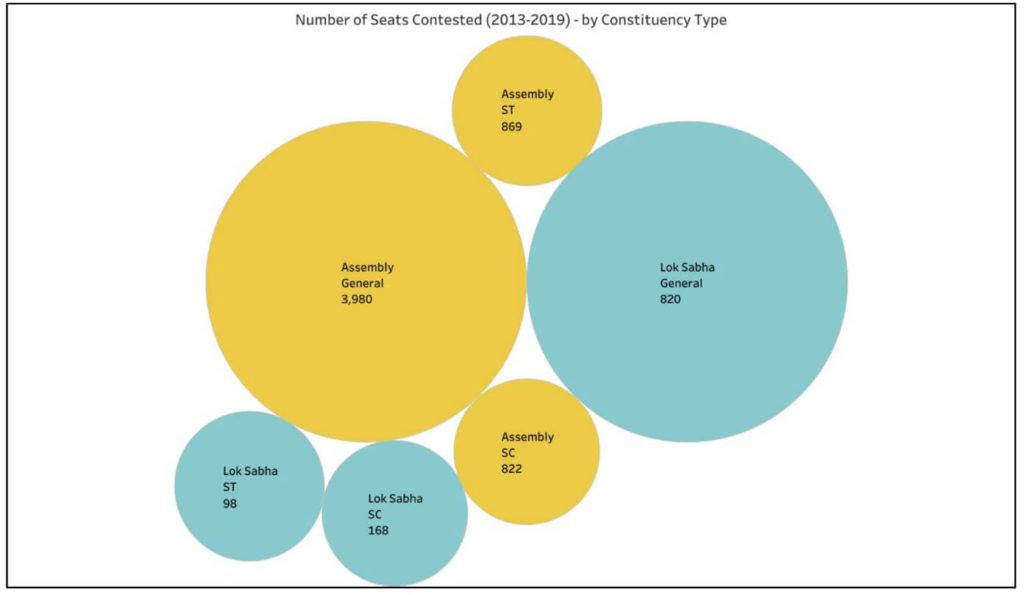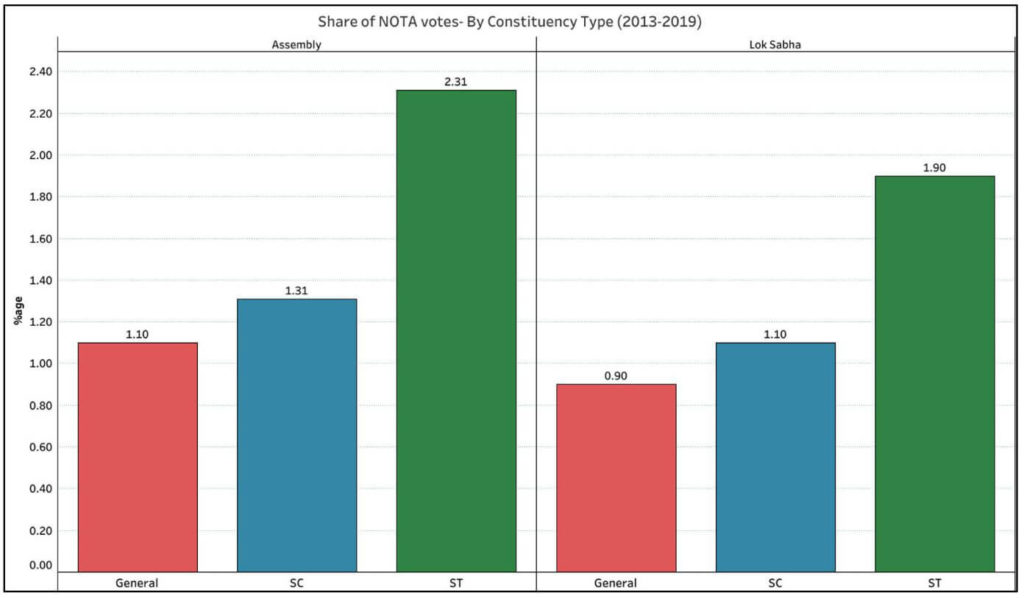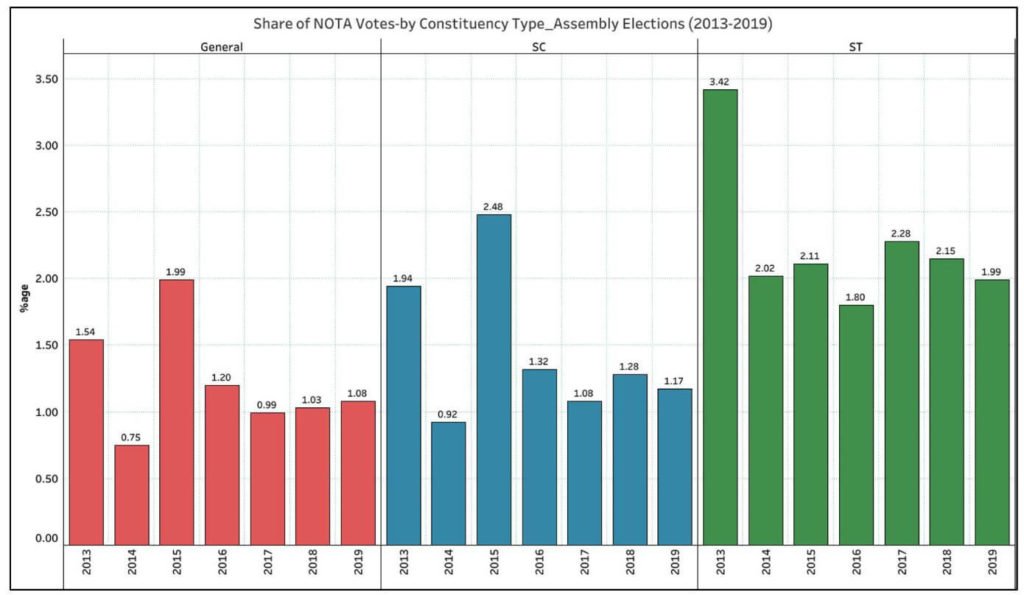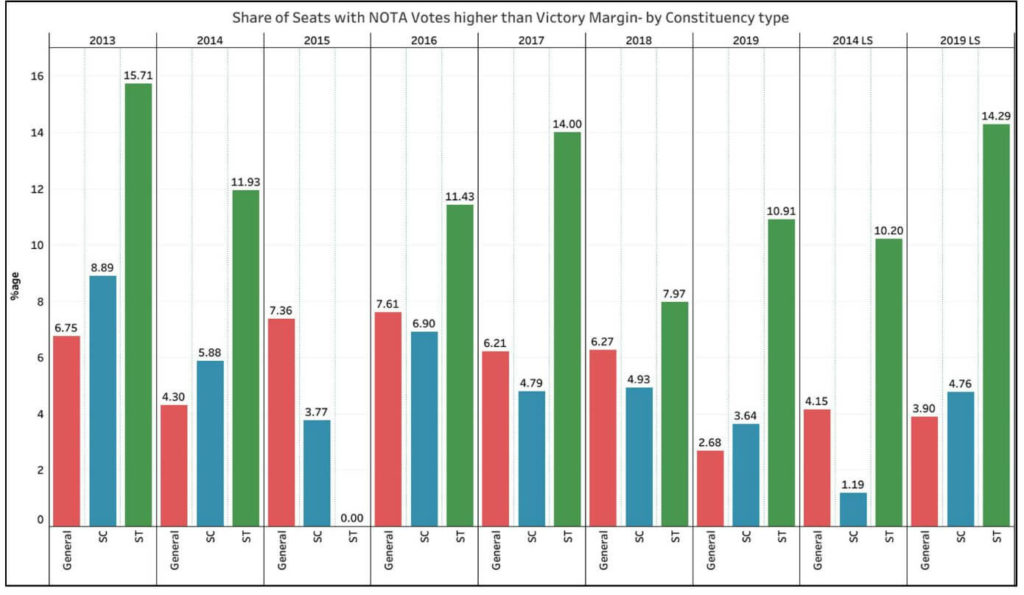It’s been 6 years since the introduction of NOTA on the EVM. Data from 46 elections and thousands of constituencies indicates that NOTA is being preferred by a fewer percentage of voters than 6 years ago. Another trend worth noting is that NOTA vote share is higher in reserved constituencies than in General constituencies.
One of the common reasons cited by the electorate regarding not voting in an election is that none of the candidates in the fray deserve to be their representative. With the introduction of NOTA in 2013, an option was provided to the electorate, who usually stay away from voting because of a lack of choice, to come forward and participate in the election process. Voting for NOTA is seen as an expression of dissent against parties and their choice of candidates.
To bolster the choice of NOTA, a dedicated symbol for NOTA was also introduced in 2015 to aid the voters who intend to use NOTA option. As observed in an earlier story on Factly, the share of votes for NOTA has been on the decline since its inception. In an another story, it was observed that while there is a decline in NOTA vote share even in the reserved seats, the vote share of NOTA in reserved seats is still substantially higher than the General category seats.
In this story, we look at the NOTA trends after the recently concluded elections for Jharkhand assembly in reserved & general constituencies. It has to be noted that only general election results are considered for this analysis.
Share of NOTA votes higher among ST reserved seats in both Assembly and Lok Sabha elections
A total of 46 elections were conducted since NOTA was introduced in 2013, of which 44 elections were Assembly general elections and 2 were for the Lok Sabha ( 2014 & 2019 ).
Of the 44 Assembly elections, the 13 states of Andhra Pradesh, Arunachal Pradesh, Chhattisgarh, Haryana, Jharkhand, Madhya Pradesh, Maharashtra, Mizoram, Delhi, Odisha, Rajasthan, Sikkim and Telangana had two assembly general elections during this period (2013- 2019).
Elections were conducted to 5671 assembly constituencies of which, 3980 seats were General category seats, 822 were SC Reserved seats and 869 were ST reserved seats.
In the two Lok Sabha general elections since 2013, 1086 constituencies went to polls of which 820 were General category seats, 168 were SC reserved and 98 ST reserved seats.

Greatest NOTA vote share in ST reserved seats
Among the elections held for various State assemblies, ST reserved seats have polled the highest share of NOTA votes with 2.31%. Out of 8.49 crores votes polled in ST reserved assembly constituencies between 2013-2019, around 19.65 lakh votes were polled for NOTA.
On the other hand, SC reserved seats polled 17.49 lakh votes for NOTA which accounts to 1.31% of 13.34 crore total votes. The least share of NOTA votes in assembly elections is among the non-reserved General Seats with only 1.1% votes going for NOTA.
Similarly, even in Lok Sabha elections, ST reserved seats have the highest share for NOTA with 1.9% of total votes polled. It is followed by SC reserved seats with 1.1% and General Seats with 0.9% for both the Lok Sabha elections held during 2014 and 2019.
Meanwhile, NOTA has a higher share in Assembly elections compared to that of Lok Sabha elections across all types of constituencies – General, SC & ST reserved.

Slight fall in the percentage of NOTA in reserved seats for 2019
Post the Lok Sabha elections in 2019, Factly highlighted the continued fall in the share of NOTA votes year on year, albeit the reserved constituencies reporting a higher share.
Post 2019 Lok Sabha elections, there were assembly general elections in the states of Maharashtra, Haryana and Jharkhand. Prior to the elections in these three states, the share of NOTA votes in the assembly elections in 2019 (for the states of Arunachal Pradesh, Andhra Pradesh, Sikkim & Odisha) was 1.01%, 1.17% and 2.1% in General, SC and ST reserved constituencies respectively.
Post the assembly elections for these three states, the NOTA vote share in SC and ST seats in 2019 was down to 1.16% and 1.99% respectively. Meanwhile, there is a slight increase in the share of NOTA votes in General constituencies, i.e. 1.08%
Specific to these three states, the share of NOTA votes was 1.13%, 1.15% and 1.91% for General, SC and ST reserved seats respectively.
The overall NOTA vote share in SC reserved seats in 2019 decreased despite a higher NOTA vote share in Jharkhand’s SC reserved seats (2.04%). The higher share in Jharkhand was offset by only 0.47% NOTA votes in SC reserved seats of Haryana.
Meanwhile, the slight increase in the NOTA share within General seats can be attributed to the 1.3% NOTA vote share in Maharashtra assembly elections. It may be noted that Latur -Rural which is a General Seat, polled the highest ever NOTA share of 13.78% in the 2019 Maharashtra Assembly elections.

As for the Lok Sabha elections, the reserved seats have a greater share of NOTA , even though the numbers have fallen in 2019 Lok Sabha elections compared to 2014.
‘NOTA votes higher than victory margin’ happens more in reserved seats
For the year 2019, in 38 Assembly constituencies and 27 Lok Sabha constituencies, the NOTA votes were higher than that of the margin of victory.
In the 2014 Lok Sabha elections, there were 23 such constituencies, with an increase in SC & ST reserved seats in 2019 Lok Sabha elections.
While, the number of assembly seats being contested every year varies depending on the size of the states where assembly elections are being conducted, the share of seats in which NOTA polled more than the victory margin has been on the decline.
In 2013, 9% of the total assembly seats contested had NOTA polling more than victory margin. The share of such seats in the subsequent years is 5.8%, 6.7% , 7.6%, 6.4%, 6.5% between 2014 -2018. This share is only 4.3% in 2019.
Among the various categories of seats, ST reserved seats have a higher share of seats where NOTA votes are more than the victory margin. In the case of Assembly elections, the trends have been inconsistent over the years.
In 2013, 15.71% of the ST reserved constituencies had NOTA polling more than the victory margin while in 2019 it was down to 10.91%. Although during the initial years, the share of these seats among SC reserved constituencies was higher than that of General seats, over the past few years, the numbers are been inconsistent.
In the case of 2014 and 2019 Lok Sabha elections, the share of these constituencies has gone up among the ST reserved seats from 10.2% to 14.29%. The share of such constituencies among SC reserved seats has gone up since there were four such SC reserved constituencies in 2019 compared to only one in 2014.

Despite the decline in NOTA as a choice, reserved seats still poll a higher NOTA share
The one stand out trend of the last 6 years is that NOTA is being chosen by fewer percentage of voters today compared to 2013. This is true both in the case of assembly as well as lok sabha elections.
Even among the SC and ST reserved seats, the NOTA share has fallen. Despite this fall, the NOTA vote share in reserved seats is substantially higher than in the general seats.
With the exception of 2019 Lok Sabha elections, the proportion of seats where NOTA polled more than the victory margin has also declined over the years. This is also a testament to fewer percentage of voters choosing NOTA.
The reasons for a higher NOTA share in SC and ST constituencies are not clearly known but as observed in an earlier story on Factly, based on various news reports , there are instances where there have been open calls by caste based groups not to vote for the reserved candidates and in cases of ST reserved constituencies, non-tribals not preferring to vote for tribal candidates.



1 Comment
Thanks for this report.